Trustworthiness in Modeling Unreinforced and Reinforced T-Joints with Finite Elements
Abstract
:1. Introduction
2. Previous Researches
2.1. Experimental Investigations
2.2. Numerical Simulations
2.3. Comparison Setup
3. Present Modeling
- Coarse mesh (average size 50 mm)
- Medium mesh (average size 20 mm)
- Fine mesh (almost the same number of elements as the medium ones but the size decreases from the ends to the intersection)
- Article mesh (same number of nodes on the edges shown in [5])
- S4R (4 nodes with reduced integration)
- S4 (4 nodes without reduced integration)
- S8R (8 nodes with reduced integration and six degrees of freedom (DOF))
- S8R5 (8 nodes with reduced integration and five DOF)
4. Results
-
- Experimental Investigations, Compression Load, EX-odd number
-
- Numerical Simulations, Compression Load, EX-odd number
-
- Experimental Investigations, Tension Load, EX-even number
-
- Numerical Simulations, Tension Load, EX-even number
4.1. Curves With Automatic Step Sequence
4.1.1. S4R Element Type
4.1.2. S4 Element Type
4.1.3. S8R Element Type
4.1.4. S8R5 Element Type
4.2. Curves With Fixed Step Sequence
4.3. Deformed Shapes
4.3.1. Failure of the Specimens with under Compression
Specimen EX-01
Specimen EX-03
Specimen EX-05
Specimen EX-07
4.3.2. Failure of the Specimens with under Tension
Specimens with Buckling EX-02, EX-04, and EX-08
Specimen EX-06
4.3.3. Failure of the Specimens with under Compression
Specimen EX-09
Specimen EX-11
4.3.4. Failure of the Specimens with under Tension
Specimen EX-10
5. Summary and Conclusions
- The difference in terms of load application does not affect the results in relevant way, since the results obtained by the automatic step sequence (i.e., unique stroke range) and those obtained by the fixed step sequence (i.e., two stroke ranges as in the experimental investigation) for the first two specimens are almost the same, except in some cases of the fixed step where it was not possible to find the convergence for all, due to the complexity caused by the double step. Therefore, the automatic step sequence was considered for the remaining samples that besides being simpler also allows an easier convergence.
- Automatic step sequence and the true stress-strain relationship without hardening after the peak load were considered. For these settings, four different mesh densities (coarse, medium, fine, and article) each one analyzed with four-element types (S4R, S4, S8R, and S8R5) were analyzed, respectively. Generally, it was possible to see that all load-ovalization curves fit quite well in the initial (linear) part with the reference investigation, and then go slightly below in the post-peak, and finally to converge almost in final value. In the first group of element types, i.e., S4R and S4, it can be seen that there is an abnormal shape of the curves, with the reverse of the ovalization, when the elements size of the mesh used are relatively small such as in the medium and fine mesh. This is valid when , i.e., the diameter of the brace is more than half of the chord one. While if this ratio is decreased to this does not occur. In contrast, the second group of element types with a higher number of nodes solves the issue of the change in direction of the ovalization for all the cases, even though a higher number of nodes leads to no convergence for some specimens.
- Due to the fact that the automatic step sequences, with no hardening simulations, have the relevant and complete data, these were compared to the references by cutting rings from the center of the chord of each specimen. The ring of the research shows a perfect matching to the experimental case under compression. In the research study, as in the numerical reference, the buckling that occurs in some of the tension cases of the experimental research was not considered. However, the shapes obtained by this research kept good accordance, even in the specimens where buckling occurred.
- Although the reliability of shell elements is the object of this research, a 3-D model with the same setting used by var der Vegte et al. [5] was built to verify the reliability of the preliminary parameters considered in the model with those of the numerical simulation [5], since assumptions were done in the first stage due to lack in the data in the reference papers. From the results of the 3-D model of this study, as depicted in Figure 16a, the load-ovalization curves in Figure 16b have been obtained where almost similar shapes and characteristics of the main model made by shells with S4 element type can be seen. Thus, it is possible to deduce that some relevant data are missing in the paper.
- The model considered in this research is able to show comparable strength characteristics as in [4,5]. In fact, the T-joints considered in this study show a great improvement in terms of strength of the specimen reinforced by doubler plate or a collar plate as compared to the strength of the unreinforced joints. An enhancement of almost 40% was reached for as in the experimental case, but a smaller value was found for where the research value is five per cent smaller than the experimental one of sixteen percent. Therefore, it can be said that the two types of reinforcement have the capacity to distribute the brace axial load to a larger region of the chord, with consequent improvement in terms of strength enhancement.
- Through the use of shell elements instead of the more expensive (in terms of computational cost) solid elements, the contact problem and the introduction of the element thickness have been solved. It turned out that shell elements with 8 nodes and reduced integration are suitable for this type of structures; this type of elements gives a reliable solution already starting from coarse meshes. Whereas the S4R elements type given by default from the software gives less precise results.
- The missing data in the reference papers have inevitably lead to some differences in the results, partially solved by the use of a different true stress-strain relationship. However, due to the good agreement between the research and the experimental results, the former can be developed through parametric studies to extend the above considerations to different types of joints. Moreover, the present research can be considered for studies involving composite materials as reinforcing phase for damaged or weak joints.
6. Future Developments
Author Contributions
Acknowledgments
Conflicts of Interest
References
- Moffat, D.G.; Kruzelecki, J.; Blachut, J. The effects of chord length and boundary conditions on the static strength of a tubular T-joint under brace compression loading. Mar. Struct. 1996, 9, 935–947. [Google Scholar] [CrossRef]
- Choo, Y.S.; Qian, X.D.; Foo, K.S. Static strength variation of thick-walled CHS X-joints with different included angles and chord stress levels. Mar. Struct. 2004, 17, 311–324. [Google Scholar] [CrossRef]
- Lee, M.M.K.; Llewelyn-Parry, A. Strength prediction for ring-stiffened DT-joints in offshore jacket structures. Eng. Struct. 2005, 27, 421–430. [Google Scholar] [CrossRef]
- Choo, Y.S.; van der Vegte, G.J.; Zettlemoyer, N.; Li, B.H.; Liew, J.Y.R. Static strength of T-joints reinforced with doubler or collar plates. I: Experimental investigations. J. Struct. Eng. 2005, 131, 119–128. [Google Scholar] [CrossRef]
- van der Vegte, G.J.; Choo, Y.S.; Liang, J.X.; Zettlemoyer, N.; Liew, J.Y.R. Static Strength of T-joints reinforced with doubler or collar plates. II: Numerical investigations. J. Struct. Eng. 2005, 131, 129–138. [Google Scholar] [CrossRef]
- Yang, J.; Shao, Y.; Chen, C. Static strength of chord reinforced tubular Y-joints under axial loading. Mar. Struct. 2012, 29, 226–245. [Google Scholar] [CrossRef]
- Ozyurt, E.; Wang, Y.C.; Tan, K.H. Elevated temperature resistance of welded tubular joints under axial load in the brace member. Eng. Struct. 2014, 59, 574–586. [Google Scholar] [CrossRef]
- Chen, Y.; Feng, R.; Wang, C. Tests of steel and composite CHS X-joints with curved chord under axial compression. Eng. Struct. 2015, 99, 423–438. [Google Scholar] [CrossRef]
- Lie, S.T.; Li, T.; Shao, Y.B.; Vipin, S.P. Plastic collapse load prediction of cracked circular hollow section gap K-joints under in-plane bending. Mar. Struct. 2016, 50, 20–34. [Google Scholar] [CrossRef]
- Qu, H.; Li, A.; Huo, J.; Liu, Y. Dynamic performance of collar plate reinforced tubular T-joint with precompression chord. Eng. Struct. 2017, 141, 555–570. [Google Scholar] [CrossRef]
- Zhu, L.; Yang, K.; Bai, Y.; Sun, H.; Wang, M. Capacity of steel CHS X-joints strengthened with external stiffening rings in compression. Thin-Walled Struct. 2017, 115, 110–118. [Google Scholar] [CrossRef]
- Đuričić, Đ.; Aleksić, S.; Šćepanović, B.; Lučić, D. Experimental, theoretical and numerical analysis of K-joint made of CHS aluminium profiles. Thin-Walled Struct. 2017, 119, 58–71. [Google Scholar] [CrossRef]
- Lan, X.; Huang, Y.; Chan, T.-M.; Young, B. Static strength of stainless steel K- and N-joints at elevated temperatures. Thin-Walled Struct. 2018, 122, 501–509. [Google Scholar] [CrossRef]
- Qu, S.; Wu, X.; Sun, Q. Experimental study and theoretical analysis on the ultimate strength of high-strength-steel tubular K-Joints. Thin-Walled Struct. 2018, 123, 244–254. [Google Scholar] [CrossRef]
- Li, X.; Zhang, L.; Xue, X.; Wang, X.; Wang, H. Prediction on ultimate strength of tube-gusset KT-joints stiffened by 1/4 ring plates through experimental and numerical study. Thin-Walled Struct. 2018, 123, 409–419. [Google Scholar] [CrossRef]
- Feng, R.; Chen, Y.; Wei, J.; He, K.; Fu, L. Behaviour of grouted stainless-steel tubular X-joints with CHS chord under axial compression. Thin-Walled Struct. 2018, 124, 323–342. [Google Scholar] [CrossRef]
- Ouakka, S. On the Static Strength of Reinforce Joints. Master’s Thesis, University of Bologna, Bologna, Italy, 2017. [Google Scholar]
- Lotsberg, I. On stress concentration factors for tubular Y- and T-Joints in frame structures. Mar. Struct. 2011, 24, 60–69. [Google Scholar] [CrossRef]
- Osawa, N.; Yamamoto, N.; Fukuoka, T.; Sawamura, J.; Nagai, H.; Maeda, S. Study on the preciseness of hot spot stress of web-stiffened cruciform welded joints derived from shell finite element analyses. Mar. Struct. 2011, 24, 207–238. [Google Scholar] [CrossRef]
- Lotfollahi-Yaghin, M.A.; Ahmadi, H. Geometric stress distribution along the weld toe of the outer brace in two-planar tubular DKT-joints: Parametric study and deriving the SCF design equations. Mar. Struct. 2011, 24, 239–260. [Google Scholar] [CrossRef]
- Cheng, B.; Qian, Q.; Zhao, X.-L. Stress concentration factors and fatigue behavior of square bird-beak SHS T-joints under out-of-plane bending. Eng. Struct. 2015, 99, 677–684. [Google Scholar] [CrossRef]
- Pradana, M.R.; Qian, X.; Swaddiwudhipong, S. Simplified Effective Notch Stress calculation for non-overlapping circular hollow section K-Joints. Mar. Struct. 2017, 55, 1–16. [Google Scholar] [CrossRef]
- Cheng, B.; Li, C.; Lou, Y.; Zhao, X.-L. SCF of bird-beak SHS X-joints under asymmetrical brace axial forces. Thin-Walled Struct. 2018, 123, 57–69. [Google Scholar] [CrossRef]
- Xia, J.; Chang, H.; Goldsworthy, H.; Bu, Y.; Lu, Y. Axial hysteretic behavior of doubler-plate reinforced square hollow section tubular T-joints. Mar. Struct. 2017, 55, 162–181. [Google Scholar] [CrossRef]
- Gao, F.; Guo, X.-Z.; Long, X.-H.; Guan, X.-Q.; Zhu, H.-P. Hysteretic behaviour of SHS brace-H-shaped chord T-joints with transverse stiffeners. Thin-Walled Struct. 2018, 122, 387–402. [Google Scholar] [CrossRef]
- Ahmadi, H.; Nejad, A.Z. Geometrical effects on the local joint flexibility of two-planar tubular DK-joints in jacket substructure of offshore wind turbines under OPB loading. Thin-Walled Struct. 2017, 114, 122–133. [Google Scholar] [CrossRef]
- Tong, L.W.; Xu, G.W.; Yang, D.L.; Mashiri, F.R.; Zhao, X.L. Fatigue behavior and design of welded tubular T-joints with CHS brace and concrete-filled chord. Thin-Walled Struct. 2017, 120, 180–190. [Google Scholar] [CrossRef]
- Dong, W.; Moan, T.; Gao, Z. Long-term fatigue analysis of multi-planar tubular joints for jacket-type offshore wind turbine in time domain. Eng. Struct. 2011, 33, 2002–2014. [Google Scholar] [CrossRef]
- Jiang, W.Q.; Wang, Z.Q.; McClure, G.; Wang, G.L.; Geng, J.D. Accurate modeling of joint effects in lattice transmission towers. Eng. Struct. 2011, 33, 1817–1827. [Google Scholar] [CrossRef]
- Cheng, S.; Becque, J. A design methodology for side wall failure of RHS truss X-joints accounting for compressive chord pre-load. Eng. Struct. 2016, 126, 689–702. [Google Scholar] [CrossRef]
- Ahmed, A.; Qian, X. A toughness-based deformation limit for fatigue-cracked X-joints under in-plane bending. Mar. Struct. 2015, 42, 33–52. [Google Scholar] [CrossRef]
- Liu, B.C. Experimental analysis of tubular joints using white light speckle method. Mar. Struct. 1995, 8, 81–91. [Google Scholar] [CrossRef]
- Pey, L.P.; Soh, A.K.; Soh, C.K. Partial implementation of compatibility conditions in modeling tubular joints using brick and shell elements. Finite Elem. Anal. Des. 1995, 20, 127–138. [Google Scholar] [CrossRef]
- Mackerle, J. Fastening and joining: Finite element and boundary element analyses—A bibliography (1992–1994). Finite Elem. Anal. Des. 1995, 20, 205–215. [Google Scholar] [CrossRef]
- Mackerle, J. Fatigue analysis with finite and boundary element methods a bibliography (1993–1995). Finite Elem. Anal. Des. 1997, 24, 187–196. [Google Scholar] [CrossRef]
- Wang, T.; Hopperstad, O.S.; Lademo, O.-G.; Larsen, P.K. Finite element analysis of welded beam-to-column joints in aluminium alloy EN AW 6082 T6. Finite Elem. Anal. Des. 2007, 44, 1–16. [Google Scholar] [CrossRef]
- Lee, C.K.; Chiew, S.P.; Lie, S.T.; Nguyen, T.B.N. Adaptive mesh generation procedures for thin-walled tubular structures. Finite Elem. Anal. Des. 2010, 46, 114–131. [Google Scholar] [CrossRef]
- Nicol, D.A.C. Creep behaviour of butt-welded joints. Int. J. Eng. Sci. 1985, 23, 541–553. [Google Scholar] [CrossRef]
- Kolpakov, A.G. Influence of non-degenerated joint on the global and local behavior of joined plates. Int. J. Eng. Sci. 2011, 49, 1216–1231. [Google Scholar] [CrossRef]
- Wu, X.-F.; Jenson, R.A. Stress-function variational method for stress analysis of bonded joints under mechanical and thermal loads. Int. J. Eng. Sci. 2011, 49, 279–294. [Google Scholar] [CrossRef]
- Chowdhury, N.M.; Wang, J.; Chiu, W.K.; Chang, P. Static and fatigue testing bolted, bonded and hybrid step lap joints of thick carbon fibre/epoxy laminates used on aircraft structures. Compos. Struct. 2016, 142, 96–106. [Google Scholar] [CrossRef]
- Shen, W.; Yan, R.; Luo, B.; Zhu, Y.; Zeng, H. Ultimate strength analysis of composite typical joints for ship structures. Compos. Struct. 2017, 171, 32–42. [Google Scholar] [CrossRef]
- Pearce, G.M.; Tao, C.; Quek, Y.H.E.; Chowdhury, N.T. A modified Arcan test for mixed-mode loading of bolted joints in composite structures. Compos. Struct. 2018, 187, 203–211. [Google Scholar] [CrossRef]
- Bigaud, J.; Aboura, Z.; Martins, A.T.; Verger, S. Analysis of the mechanical behavior of composite T-joints reinforced by one side stitching. Compos. Struct. 2018, 184, 249–255. [Google Scholar] [CrossRef]
- Liu, F.; Lu, X.; Zhao, L.; Zhang, J.; Xu, J.; Hu, N. Investigation of bolt load redistribution and its effect on failure prediction in double-lap, multi-bolt composite joints. Compos. Struct. 2018, 202, 397–405. [Google Scholar] [CrossRef]
- Liu, Y.; Lemanski, S.; Zhang, X. Parametric study of size, curvature and free edge effects on the predicted strength of bonded composite joints. Compos. Struct. 2018, 202, 364–373. [Google Scholar] [CrossRef]
- API—American Petroleum Institute. Available online: http://www.api.org/ (accessed on 17 February 2019).
- ISO—International Organization for Standardization. Available online: https://www.iso.org/ (accessed on 17 February 2019).
- ABS—American Bureau of Shipping ABS. Available online: https://ww2.eagle.org/en.html (accessed on 17 February 2019).
- Gardner, L.; Nethercot, D.A. Guida all’Eurocodice 3. Progettazione di Edifici in Acciaio: EN 1993-1-1, -1-3 e -1-8; EPC Editore: Roma, Italy, 2012. (In Italian) [Google Scholar]
- Abaqus 6.14 Documentation: Abaqus/CAE User’s Guide. Available online: http://ivt-abaqusdoc.ivt.ntnu.no:2080/v6.14/books/usi/default.htm (accessed on 17 February 2019).
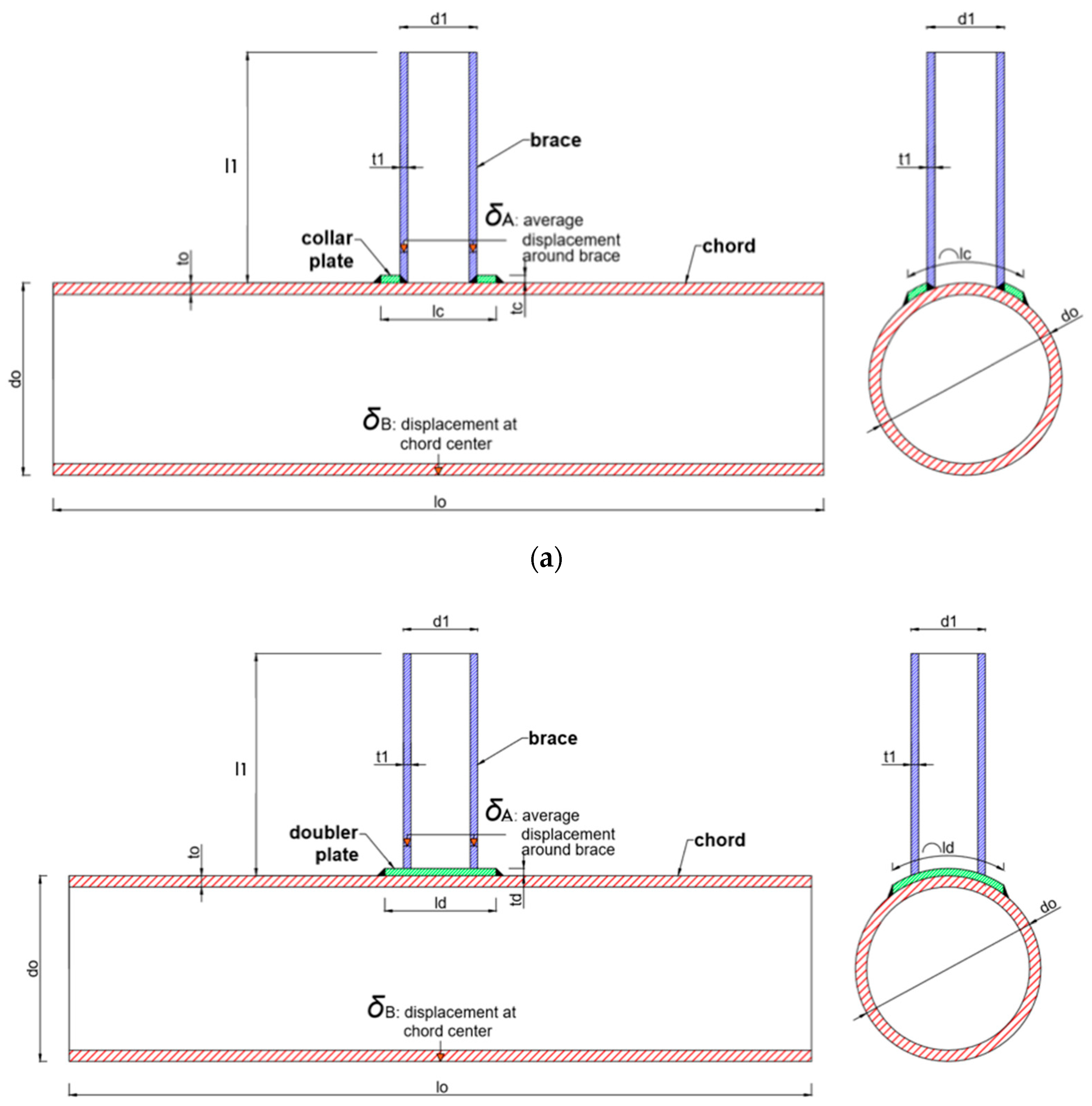

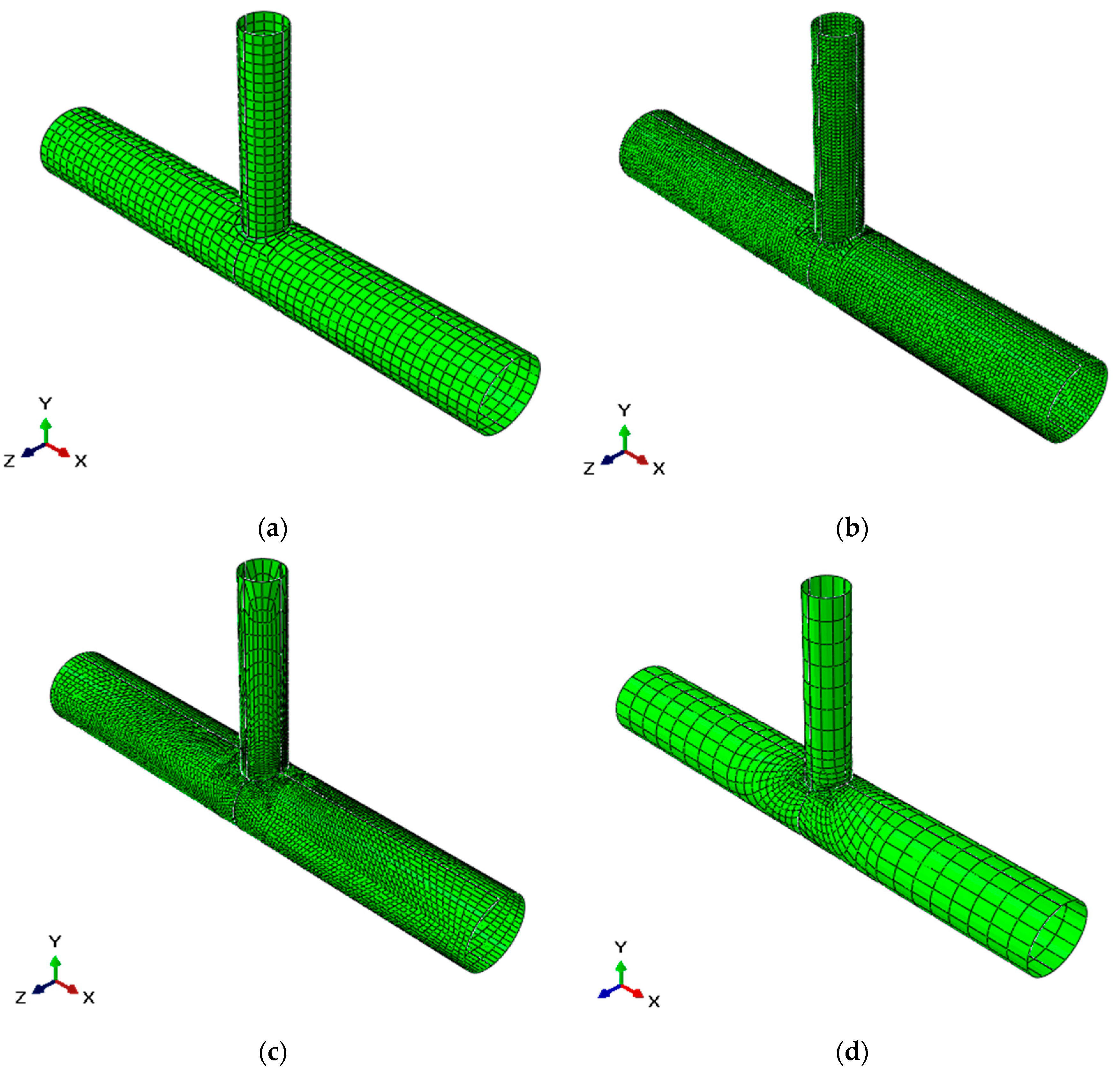
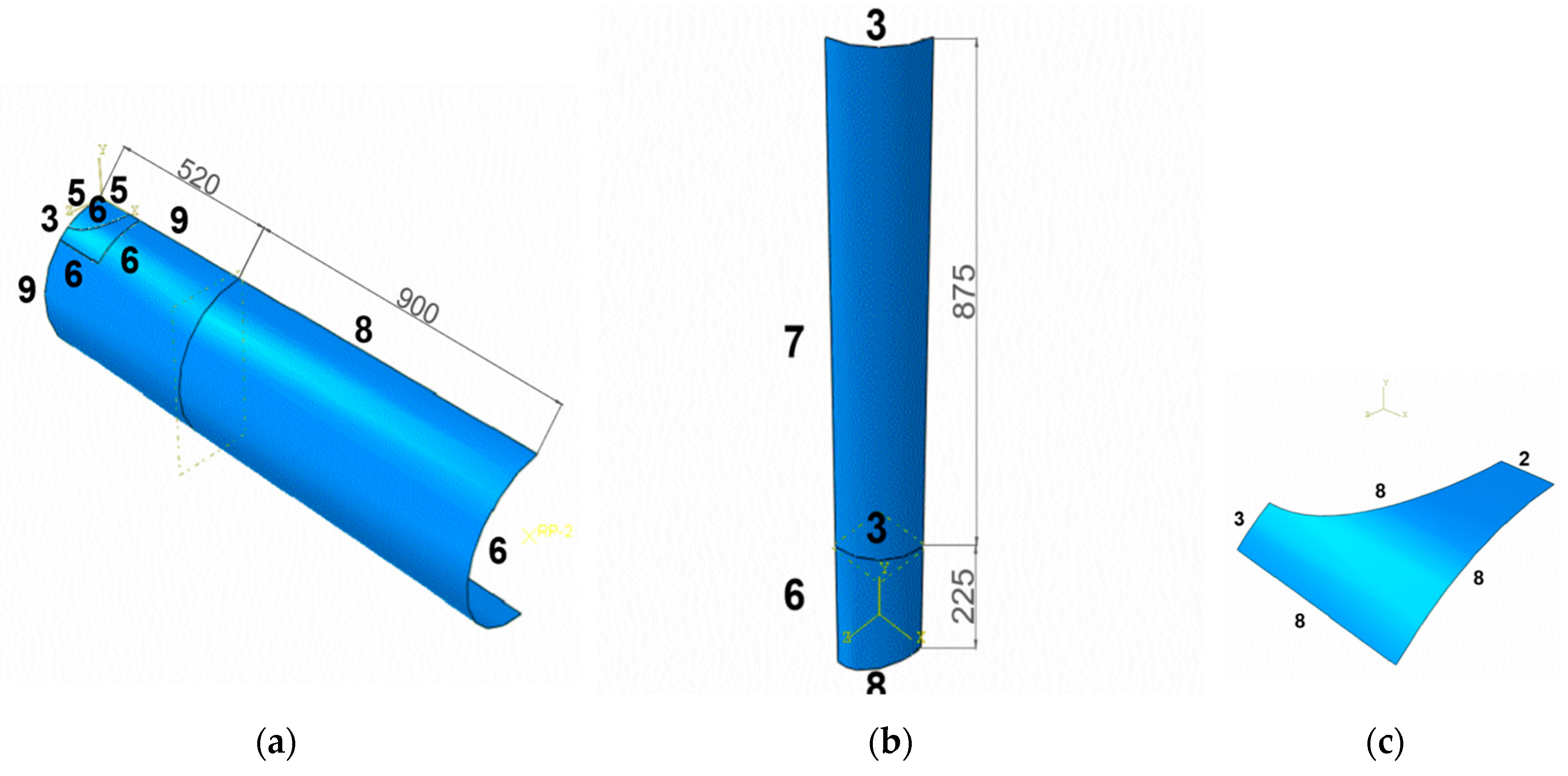
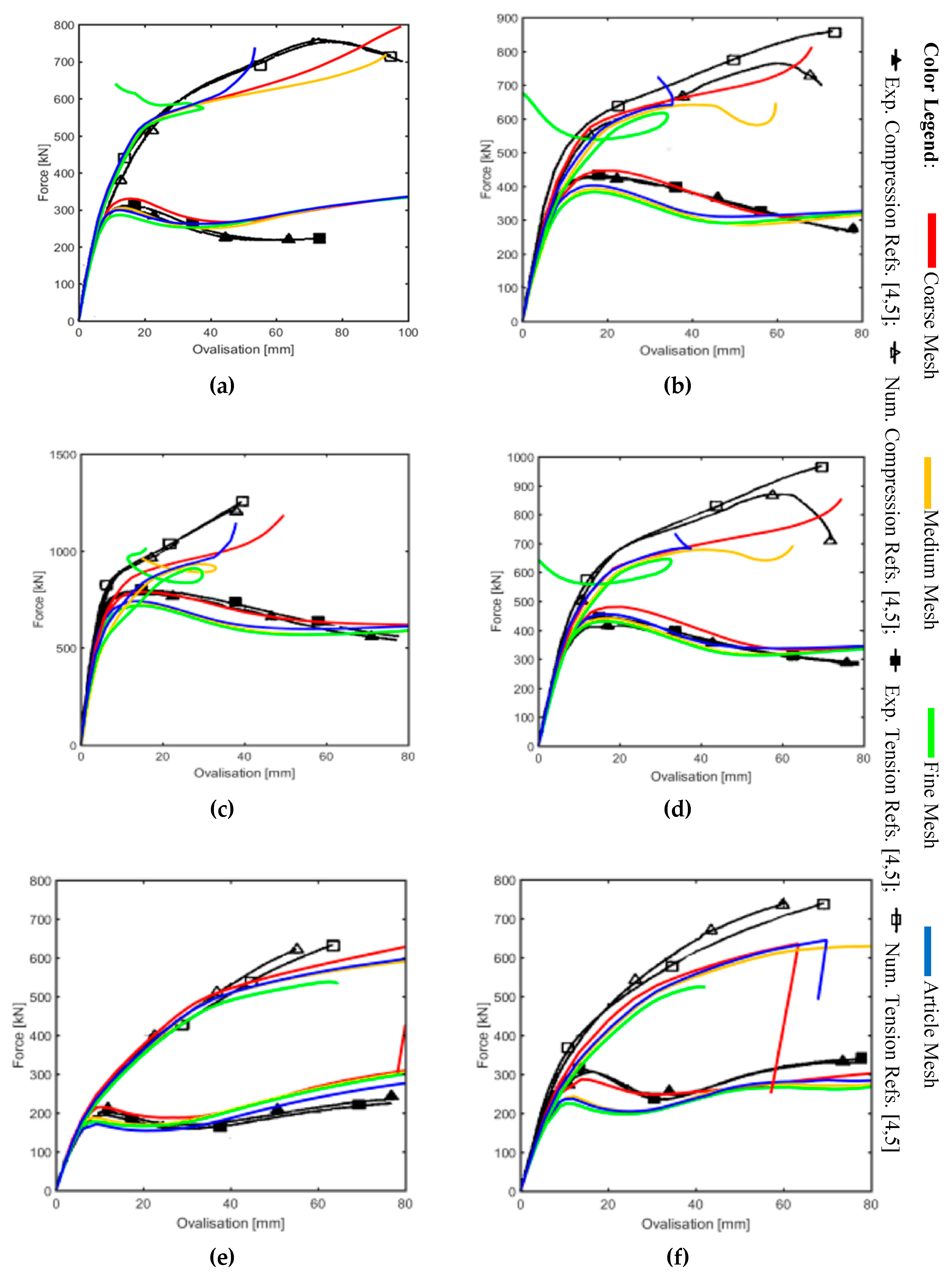
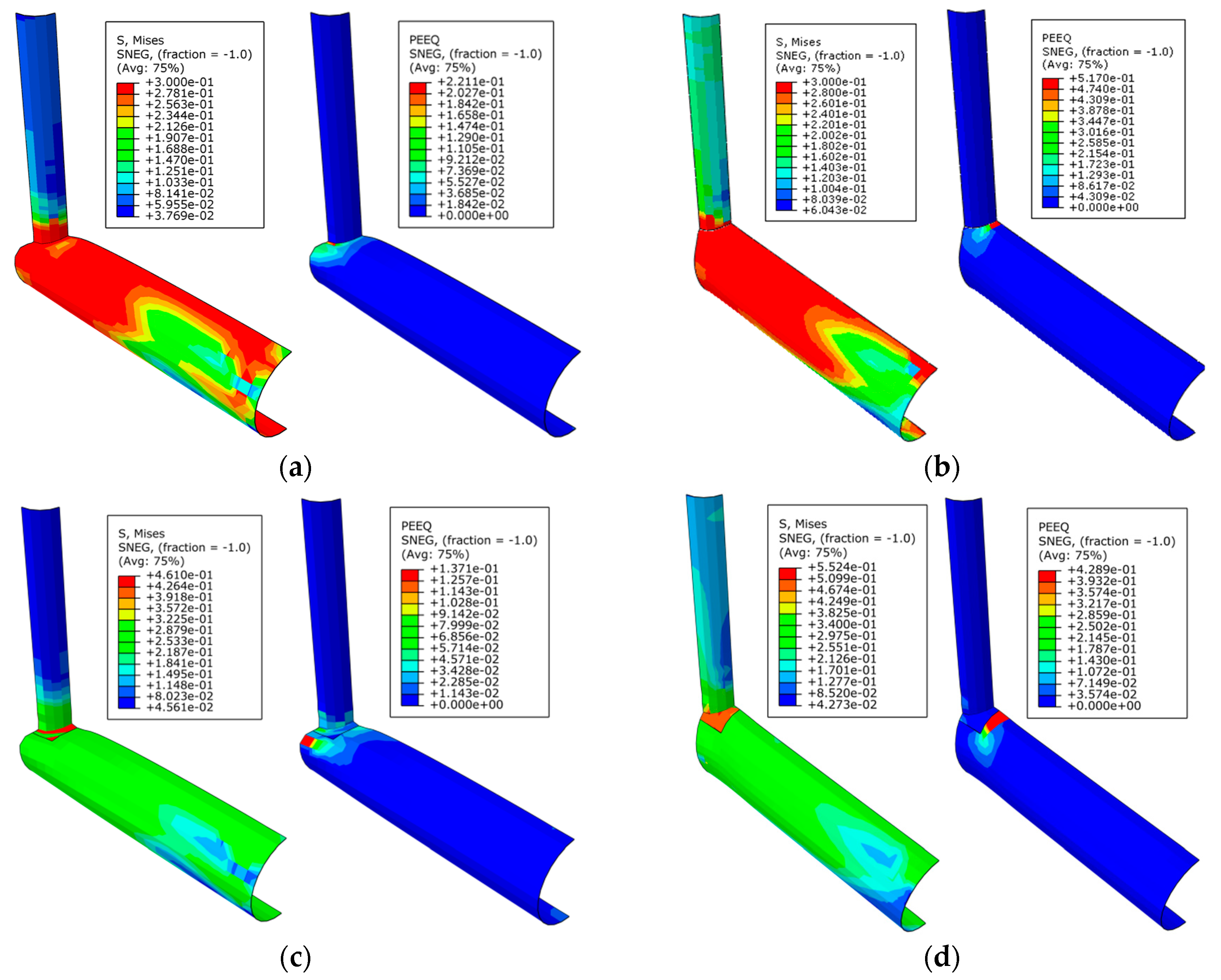
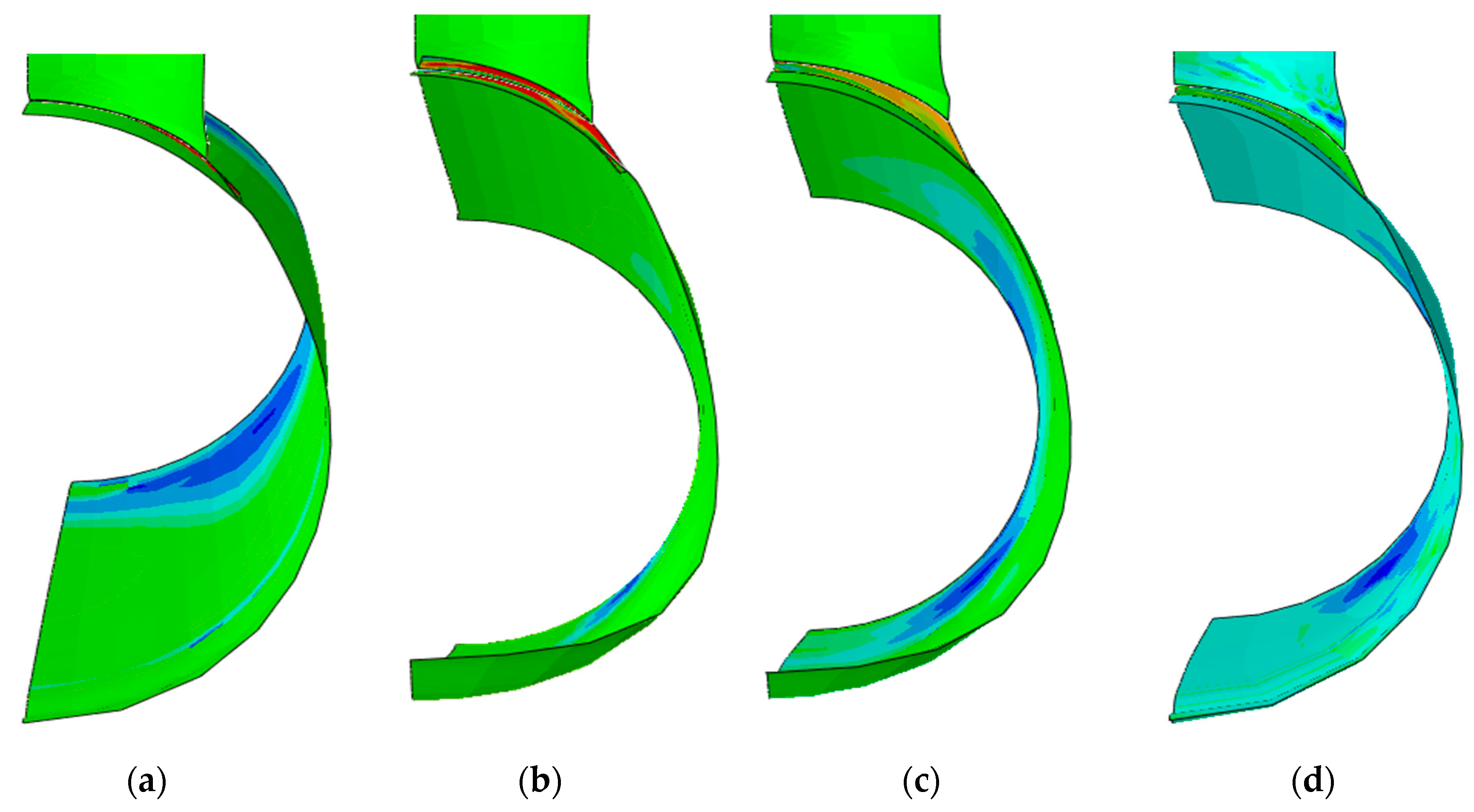
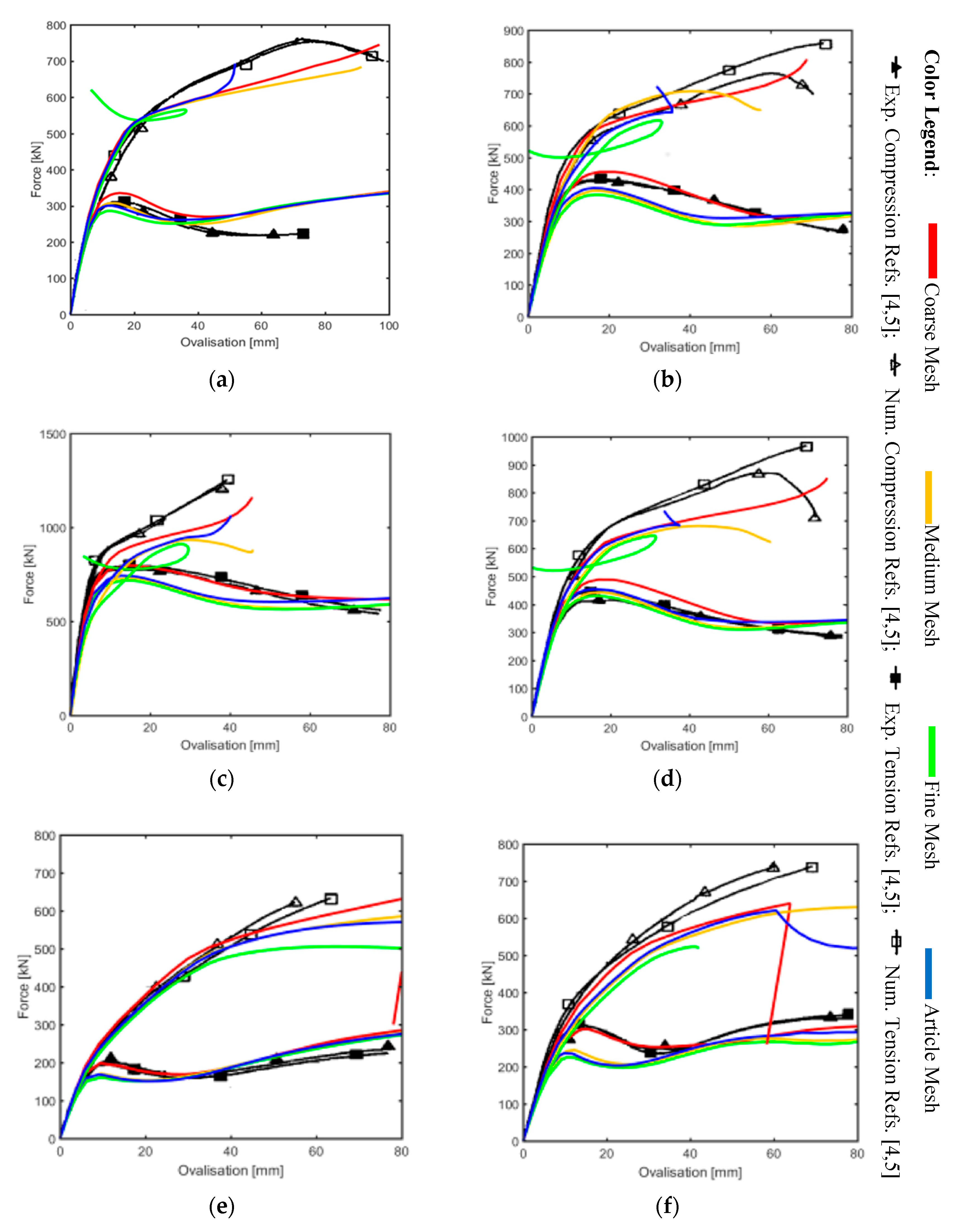
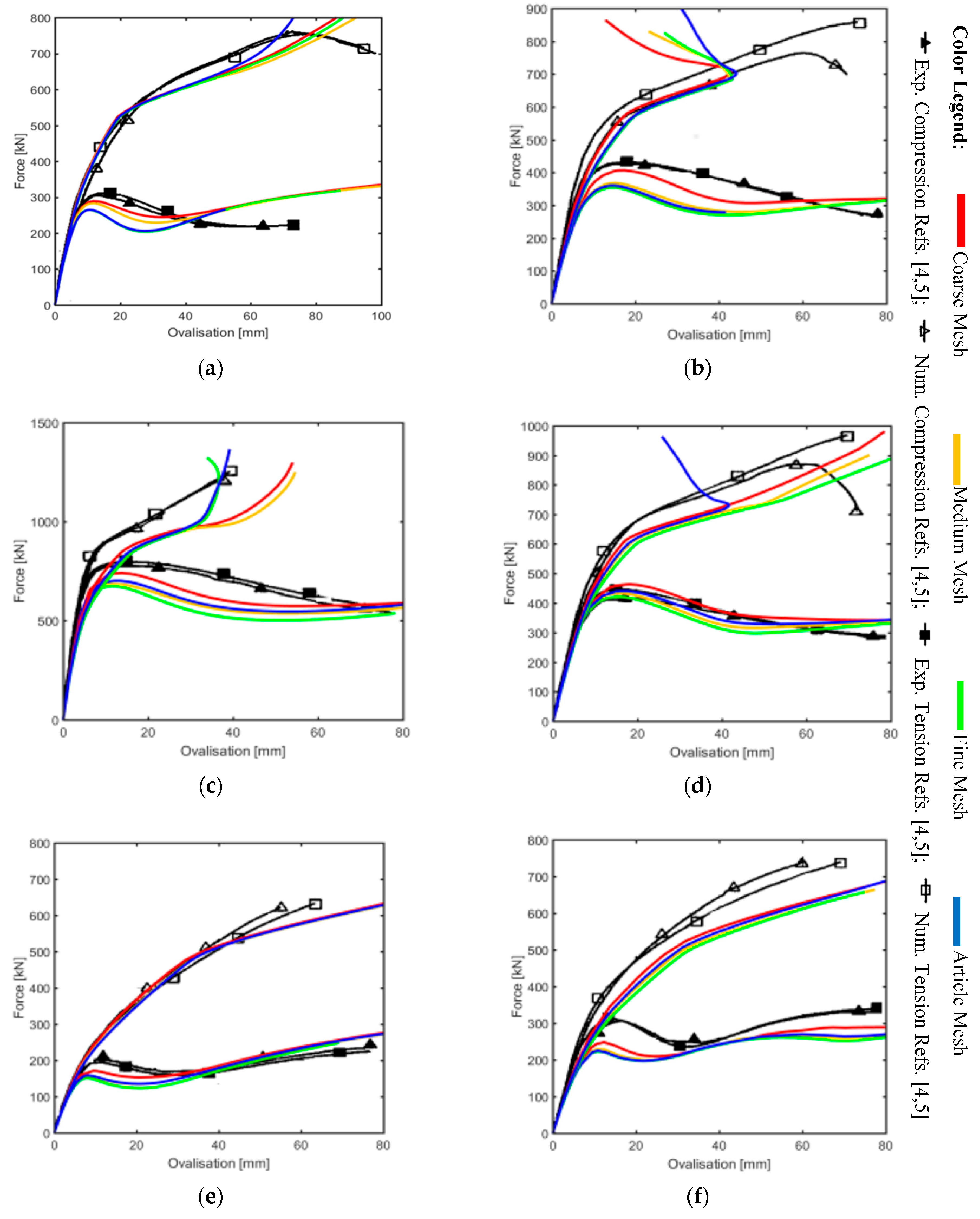
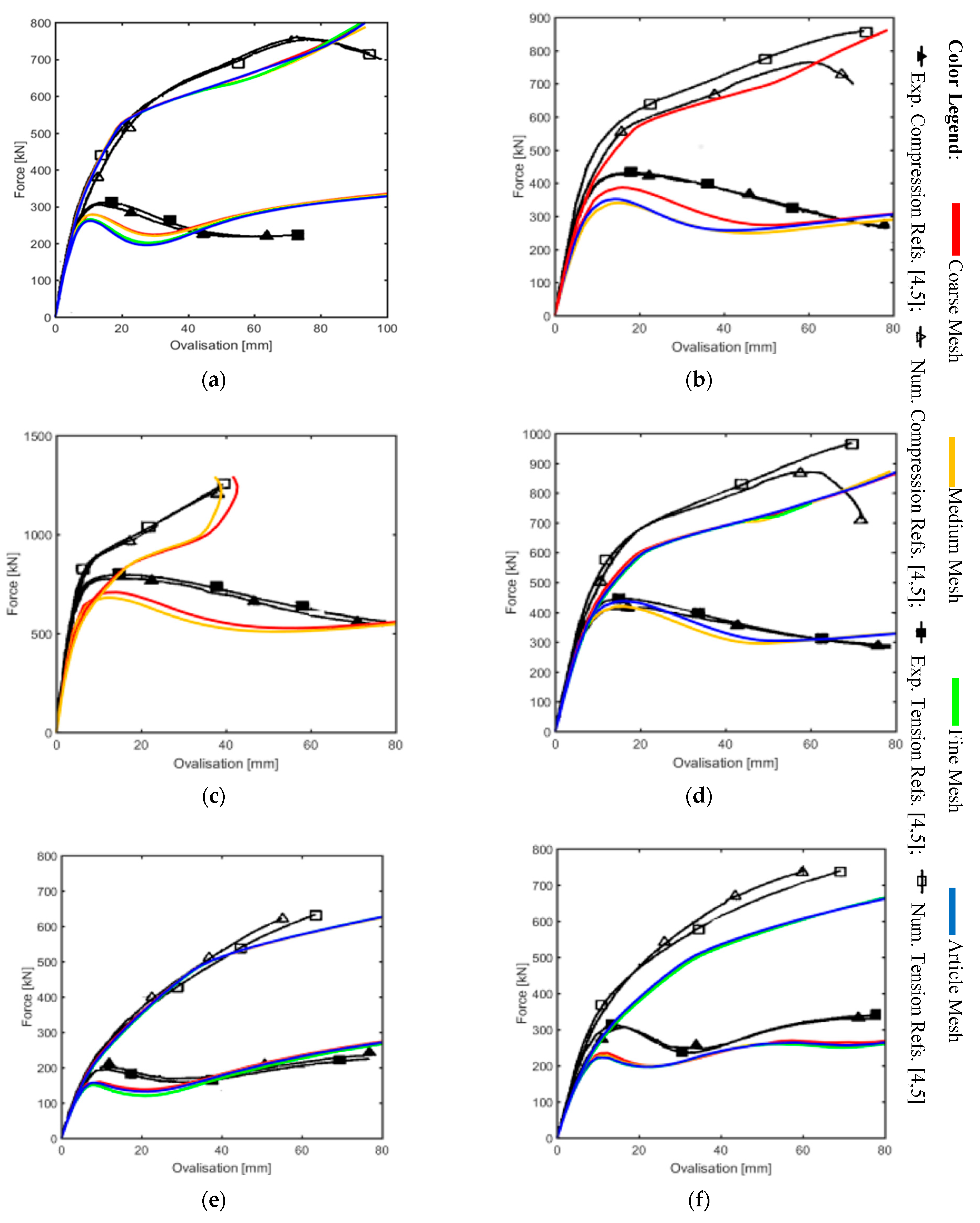
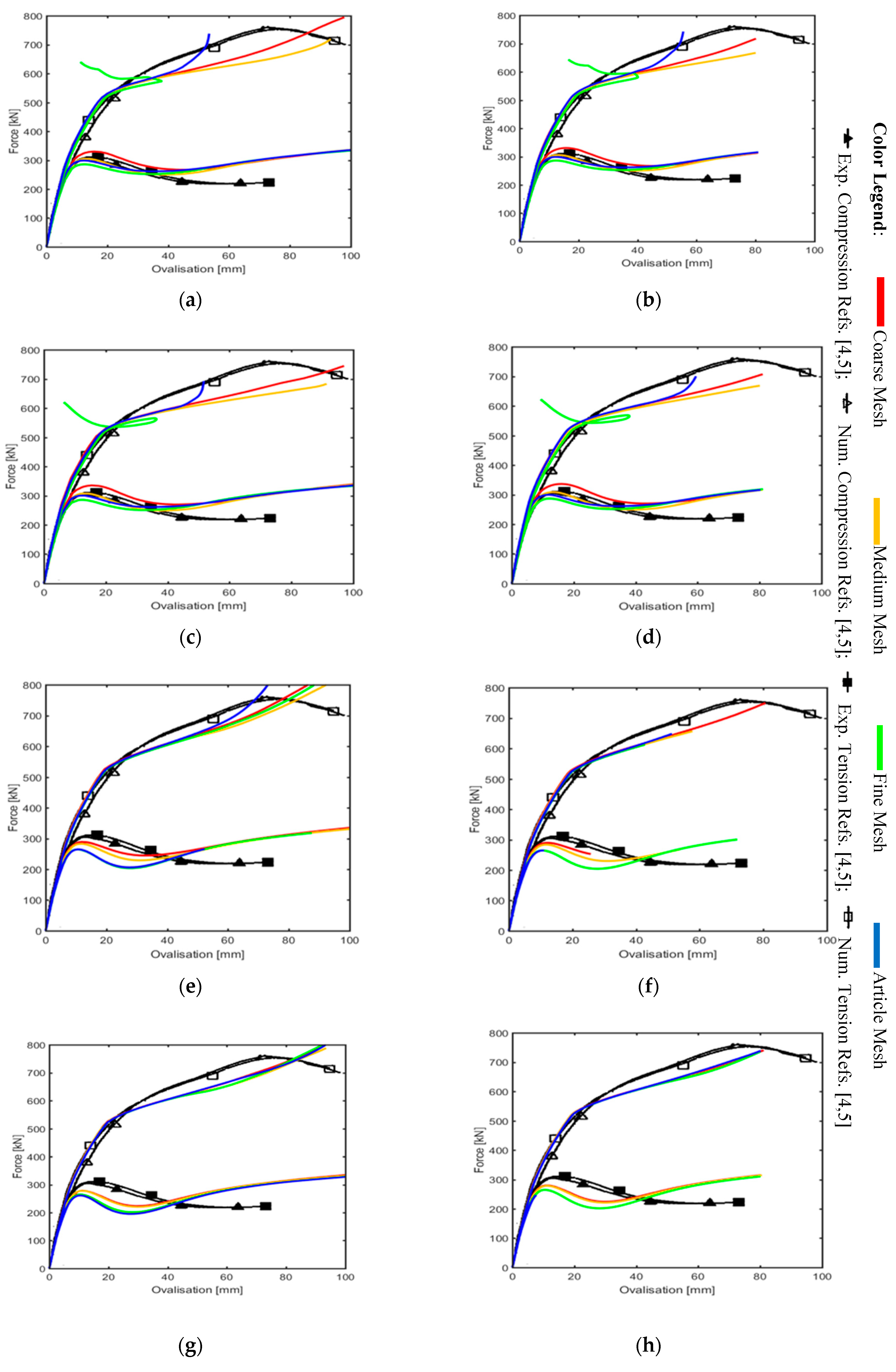

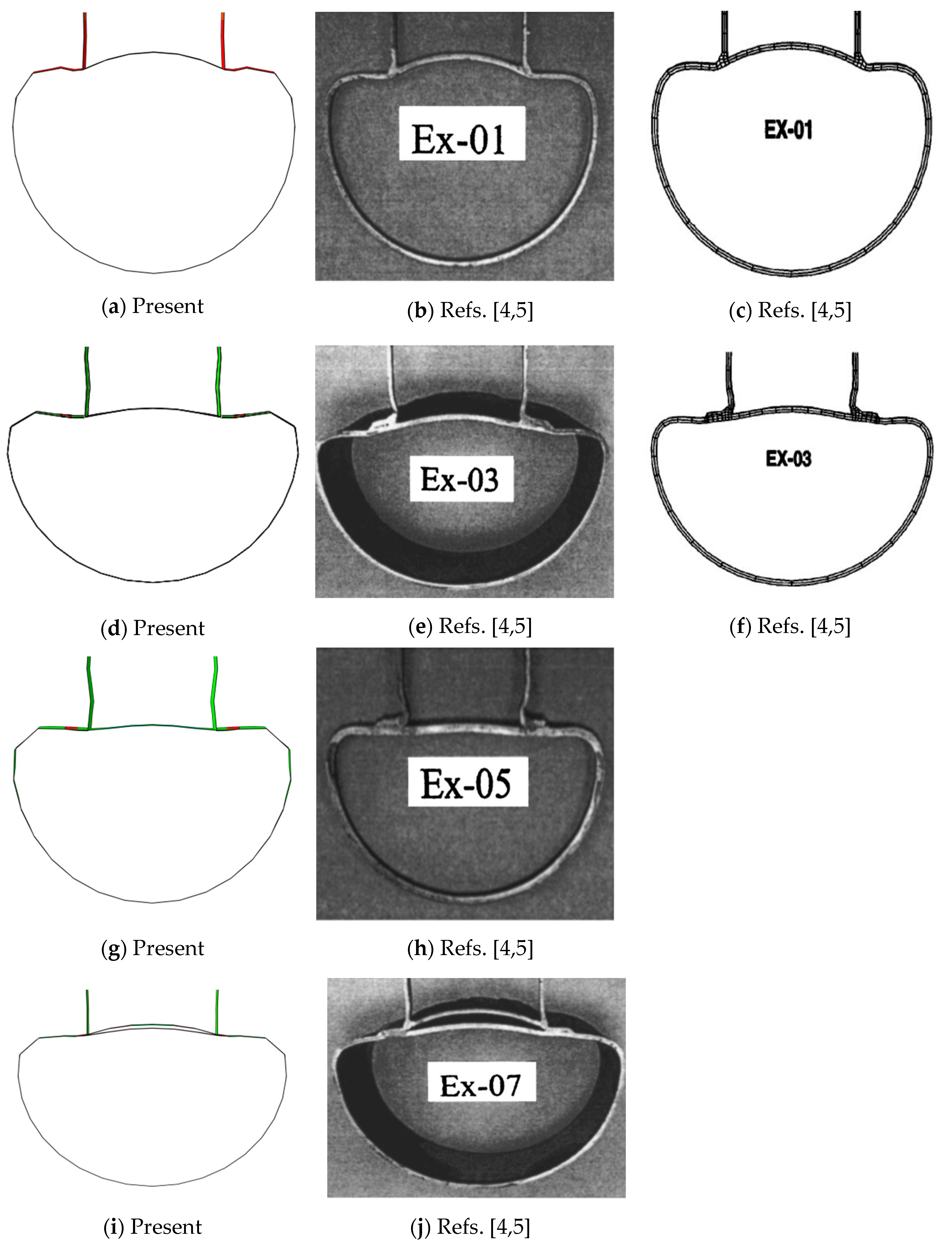

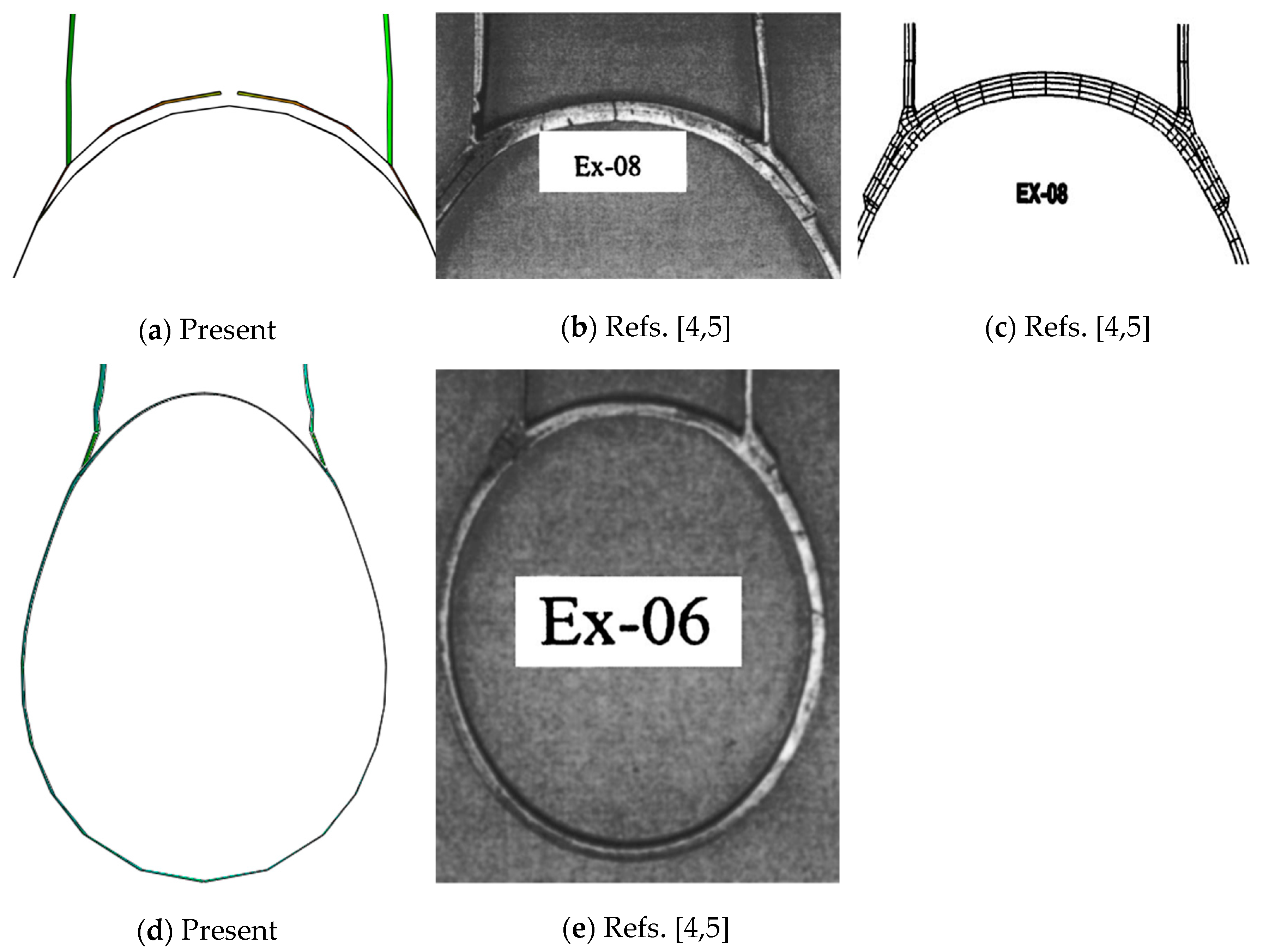
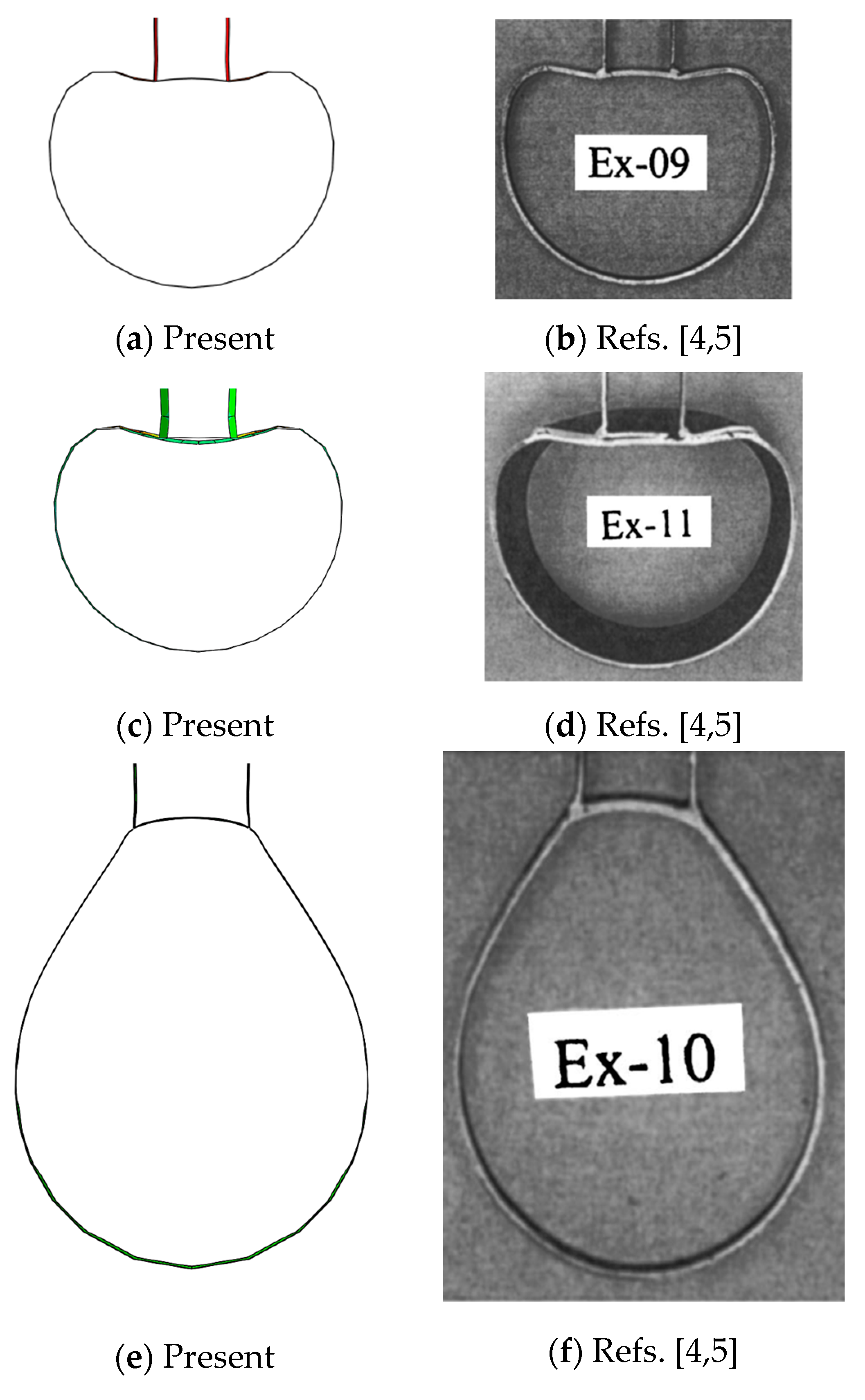
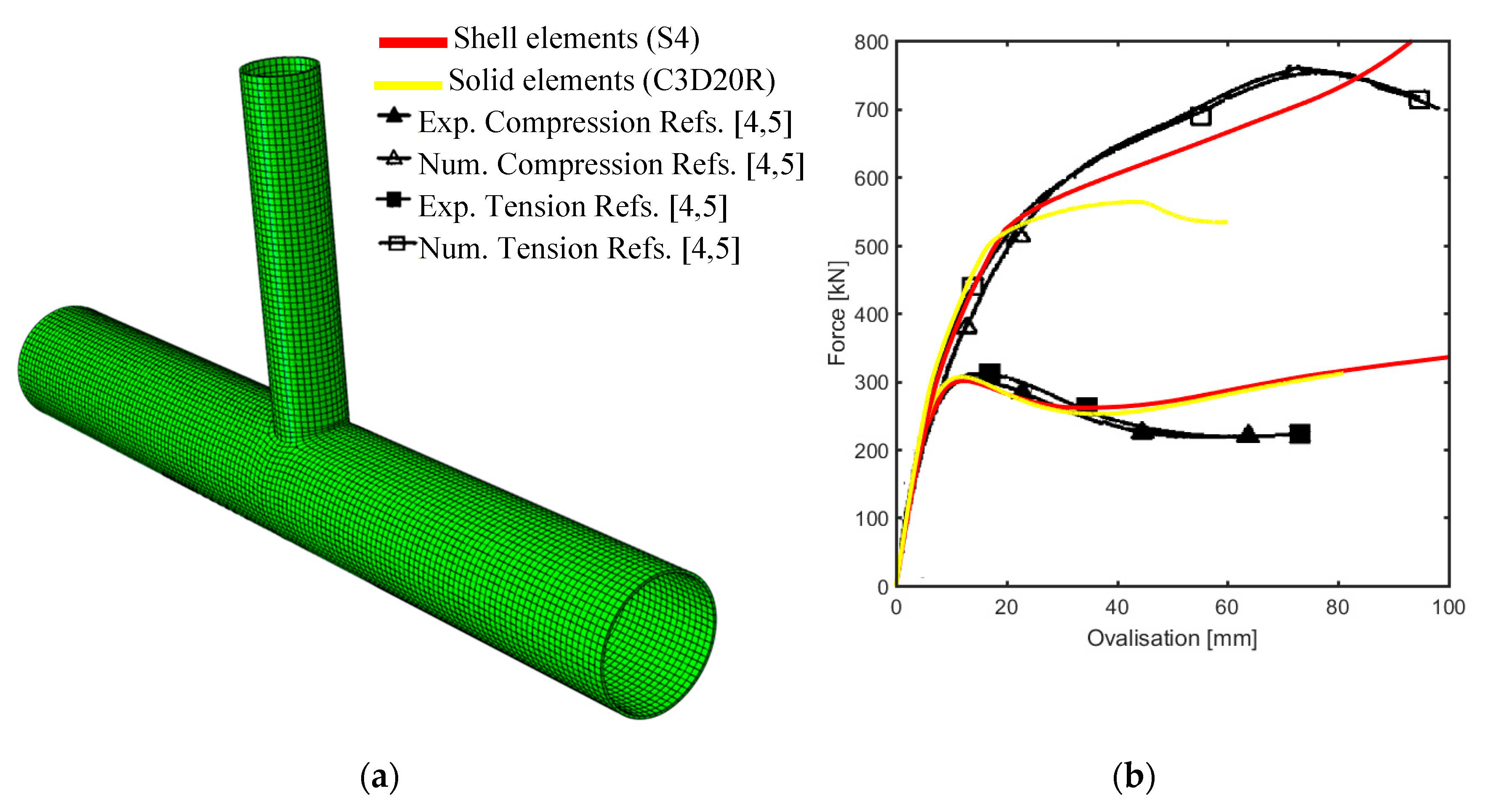
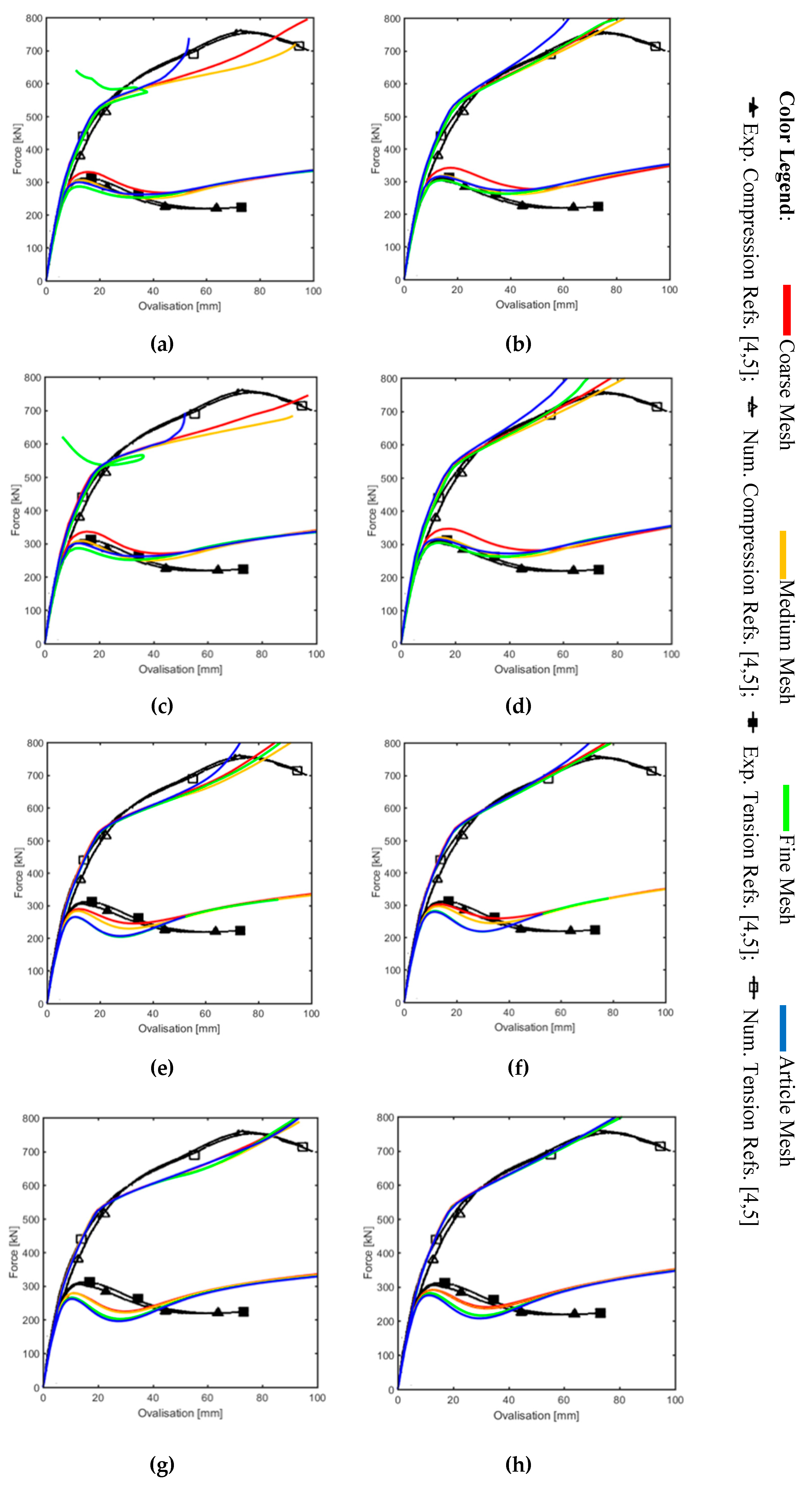
| Type | Brace Loading | ||||||
|---|---|---|---|---|---|---|---|
| Unreinforced | 409.5 | 221.9 | 8.1 | 6.8 | - | Compression | |
| Unreinforced | 409.5 | 221.9 | 8.1 | 6.8 | - | Tension | |
| Collar | 409.5 | 221.9 | 8.1 | 6.8 | 6.4 | Compression | |
| Collar | 409.5 | 221.9 | 8.5 | 6.8 | 6.4 | Tension | |
| Collar | 409.5 | 221.9 | 12.8 | 8.4 | 8.3 | Compression | |
| Collar | 409.5 | 221.9 | 12.8 | 8.4 | 8.3 | Tension | |
| Doubler | 409.5 | 221.9 | 8.5 | 6.8 | 6.6 | Compression | |
| Doubler | 409.5 | 221.9 | 8.2 | 6.5 | 6.4 | Tension | |
| Unreinforced | 409.5 | 114.7 | 8.5 | 5.9 | - | Compression | |
| Unreinforced | 409.5 | 114.7 | 8.5 | 5.9 | - | Tension | |
| Doubler | 409.5 | 114.7 | 8.5 | 5.9 | 6.6 | Compression | |
| Doubler | 409.5 | 114.7 | 8.5 | 5.9 | 6.6 | Tension |
| 285 | 300 | - | |
| 285 | 300 | - | |
| 285 | 300 | 461 | |
| 276 | 300 | 461 | |
| 276 | 275 | 464 | |
| 276 | 275 | 464 | |
| 276 | 300 | 461 | |
| 312 | 284 | 461 | |
| 276 | 312 | - | |
| 276 | 312 | - | |
| 276 | 312 | 461 | |
| 276 | 312 | 461 |
| 305.1 | 310.9 | 1.02 | |
| 543.2 | 557.8 | 1.03 | |
| 425.6 | 431.4 | 1.01 | |
| 609.2 | 648.9 | 1.07 | |
| 780.0 | 798.5 | 1.02 | |
| 1065.3 | 1069.3 | 1.00 | |
| 415.8 | 446.4 | 1.07 | |
| 708.0 | 712.2 | 1.01 | |
| 200.1 | 193.0 | 0.96 | |
| 407.8 | 393.7 | 0.97 | |
| 305.0 | 309.3 | 1.01 | |
| 520.0 | 506.2 | 0.97 |
| Specimen | Experimental Investigation | Preliminary Simulation 1 203 ν = 0.25 | Preliminary Simulation 2 210 ν = 0.25 | Preliminary Simulation 3 210 ν = 0.30 |
|---|---|---|---|---|
| 285 | 285 | 285 | 285 | |
| 8.1 | 8.1 | 8.1 | 8.1 | |
| 16.32 | 13.95 | 14.09 | 14.11 |
| Element Type Mesh EX-01 and Ex-02 | Density Mesh | Starting Point of Plastic Behavior |
|---|---|---|
| S4R | Coarse Medium Fine Article | 0.009 0.009 0.009 0.009 |
| S4 | Coarse Medium Fine Article | 0.009 0.009 0.009 0.009 |
| S8R | Coarse Medium Fine Article | 0.009 0.006 0.006 0.006 |
| S8R5 | Coarse Medium Fine Article | 0.009 0.006 0.006 0.006 |
© 2019 by the authors. Licensee MDPI, Basel, Switzerland. This article is an open access article distributed under the terms and conditions of the Creative Commons Attribution (CC BY) license (http://creativecommons.org/licenses/by/4.0/).
Share and Cite
Ouakka, S.; Fantuzzi, N. Trustworthiness in Modeling Unreinforced and Reinforced T-Joints with Finite Elements. Math. Comput. Appl. 2019, 24, 27. https://doi.org/10.3390/mca24010027
Ouakka S, Fantuzzi N. Trustworthiness in Modeling Unreinforced and Reinforced T-Joints with Finite Elements. Mathematical and Computational Applications. 2019; 24(1):27. https://doi.org/10.3390/mca24010027
Chicago/Turabian StyleOuakka, Slimane, and Nicholas Fantuzzi. 2019. "Trustworthiness in Modeling Unreinforced and Reinforced T-Joints with Finite Elements" Mathematical and Computational Applications 24, no. 1: 27. https://doi.org/10.3390/mca24010027
APA StyleOuakka, S., & Fantuzzi, N. (2019). Trustworthiness in Modeling Unreinforced and Reinforced T-Joints with Finite Elements. Mathematical and Computational Applications, 24(1), 27. https://doi.org/10.3390/mca24010027










